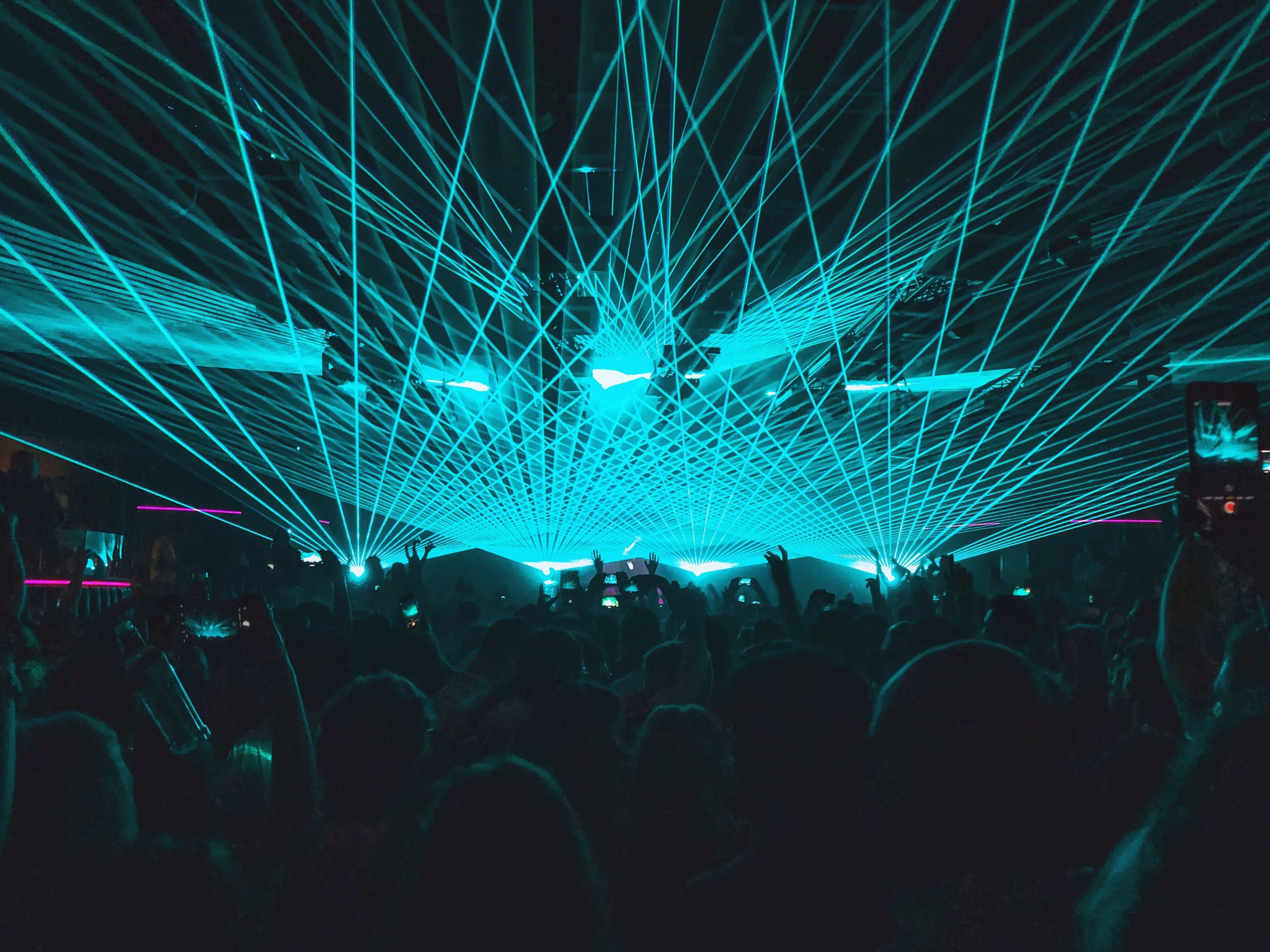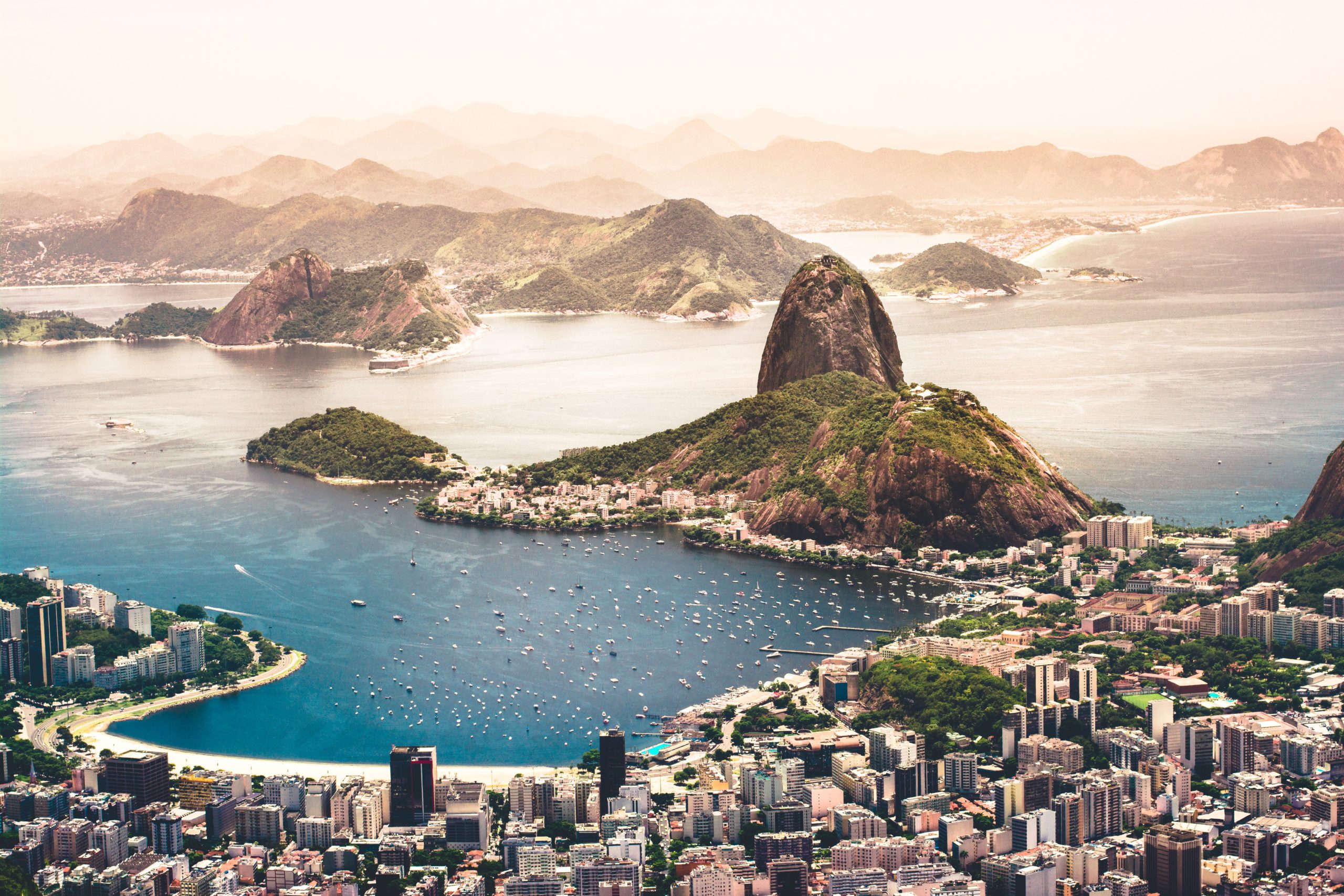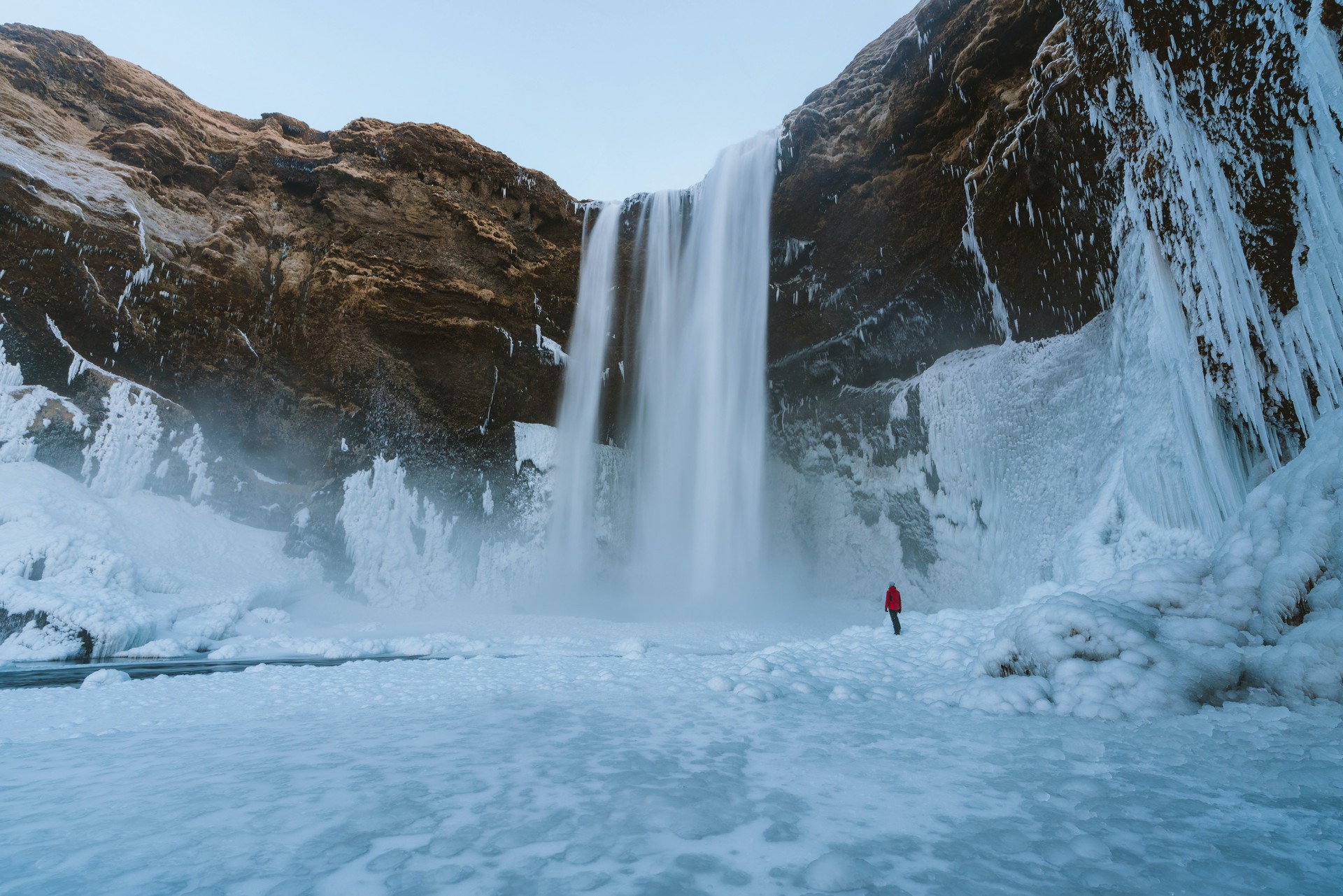Dreaming of a place where the mountains hum with prayer, ancient fortresses cling to cliffsides, and time itself seems to soften? Welcome to Bhutan, a hidden kingdom tucked high in the Eastern Himalayas, where mist weaves through pine forests and monks chant in centuries-old temples. Here, fluttering prayer flags carry wishes into the wind, and every trail, stupa, and village whispers stories of devotion. Bhutan is not just a destination, it’s an invitation to travel with purpose. For first-timers adventurers, here are 9 things to do in Bhutan that you cannot miss.
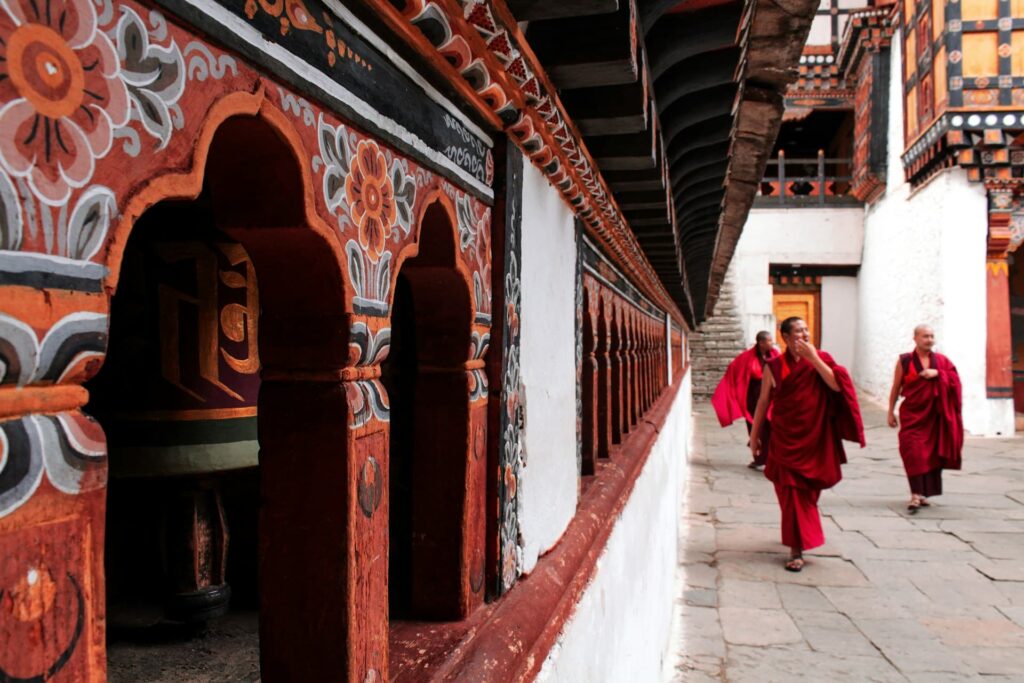
👉 Each experience on this list is easily accessible from Bhutan’s main travel hubs like Paro and Thimphu — perfect for first-timers easing into the kingdom’s magic. If you’re the type who craves deeper immersion, don’t worry, we’ve got you covered. Read our detailed guide to Bhutan’s hidden gems.
On the map: Where is Bhutan?
Tucked between India and China, Bhutan is a small, landlocked country in South Asia that stretches across a breathtaking range of elevations — from subtropical valleys to snowy Himalayan peaks. While compact in size, Bhutan is remarkably diverse in ecology, culture, and experience.
The capital city, Thimphu, sits cradled in a high-altitude valley and is unlike any capital in the world. There are no traffic lights — just a white-gloved officer guiding cars at the main intersection. It’s a place where tradition walks hand-in-hand with quiet modernity.
Bhutan is one of the last remaining Buddhist kingdoms, and its cultural integrity is fiercely protected. Travel here is intentional, immersive, and often transformative. From hiking cliffside monasteries to attending vibrant tshechus, every moment feels imbued with deeper meaning.
1. Explore the historic streets of Paro
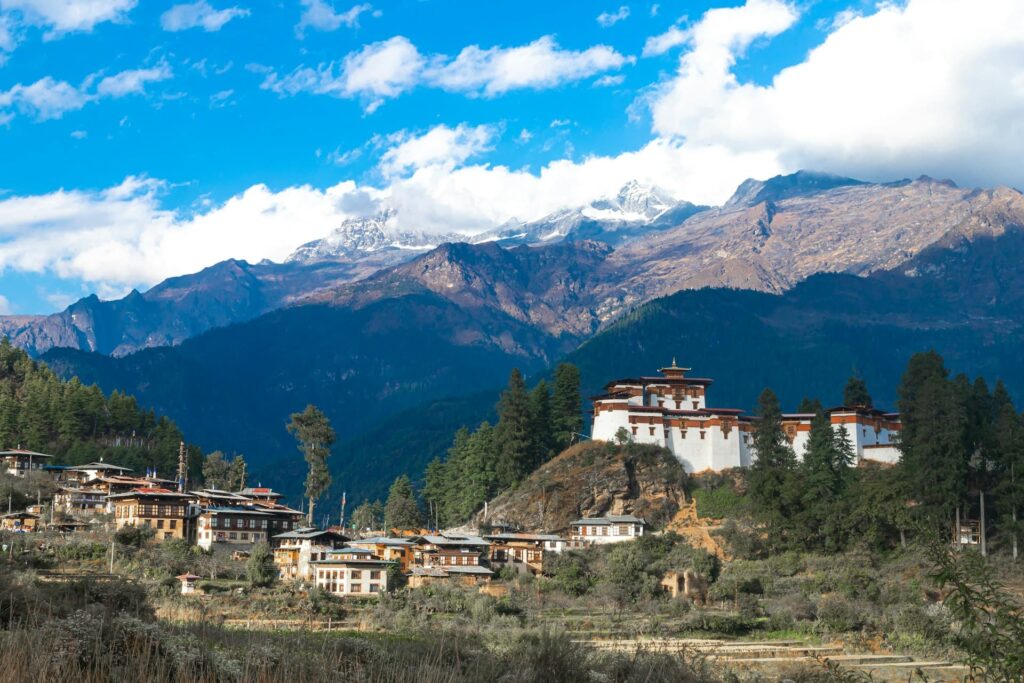
Cradled in a sweeping valley lined with terraced fields and traditional homes, Paro welcomes you with an old-world charm that’s both peaceful and photogenic. As the entry point for most travelers — home to Bhutan’s only international airport — it might be tempting to breeze through this place. But linger a little, and you’ll discover that Paro is more than a pitstop. For first-time visitors, Paro offers a gentle introduction to Bhutanese culture and remains one of the most charming places to explore in the country.
Wooden shopfronts painted in traditional motifs line the main street, where locals greet you with quiet smiles and open curiosity. The air smells faintly of roasted buckwheat and incense. Cows occasionally wander across the road. And behind it all, the valley walls rise steadily, dotted with fluttering prayer flags and scattered farmhouses. Life moves slowly here — and that’s the point.
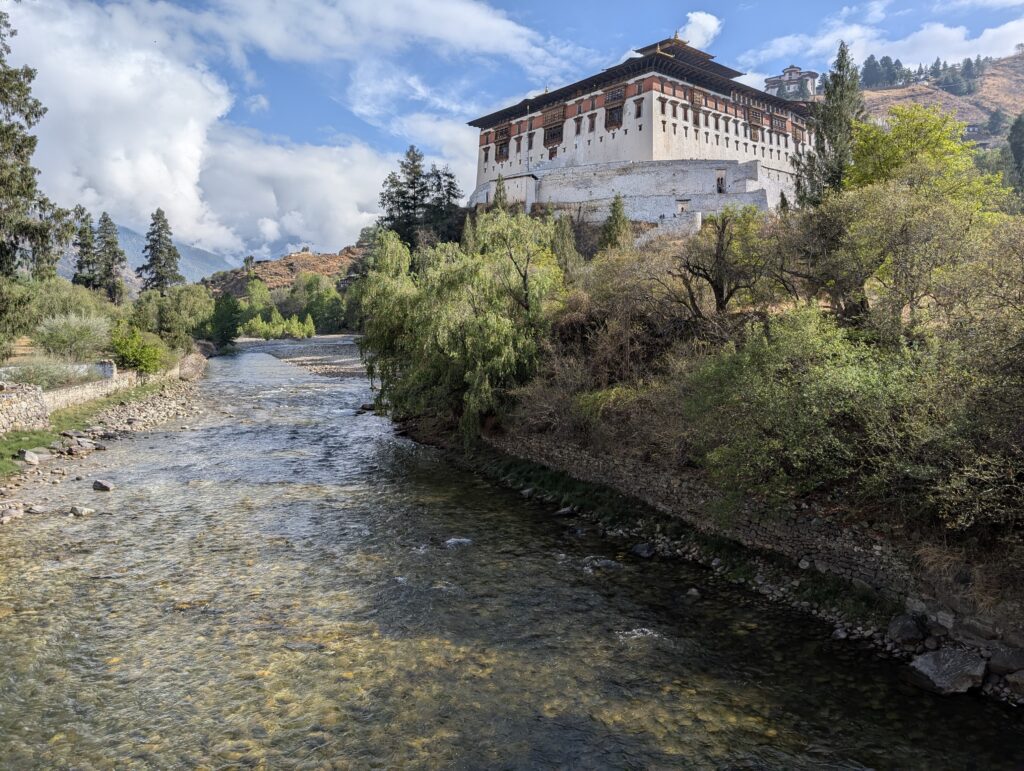
Highlights in Paro:
- Paro Rinpung Dzong: A majestic 17th-century fortress rising above the Paro Chhu river. Cross its picturesque wooden bridge and step into a courtyard alive with monastic life, painted walls, and carved balconies.
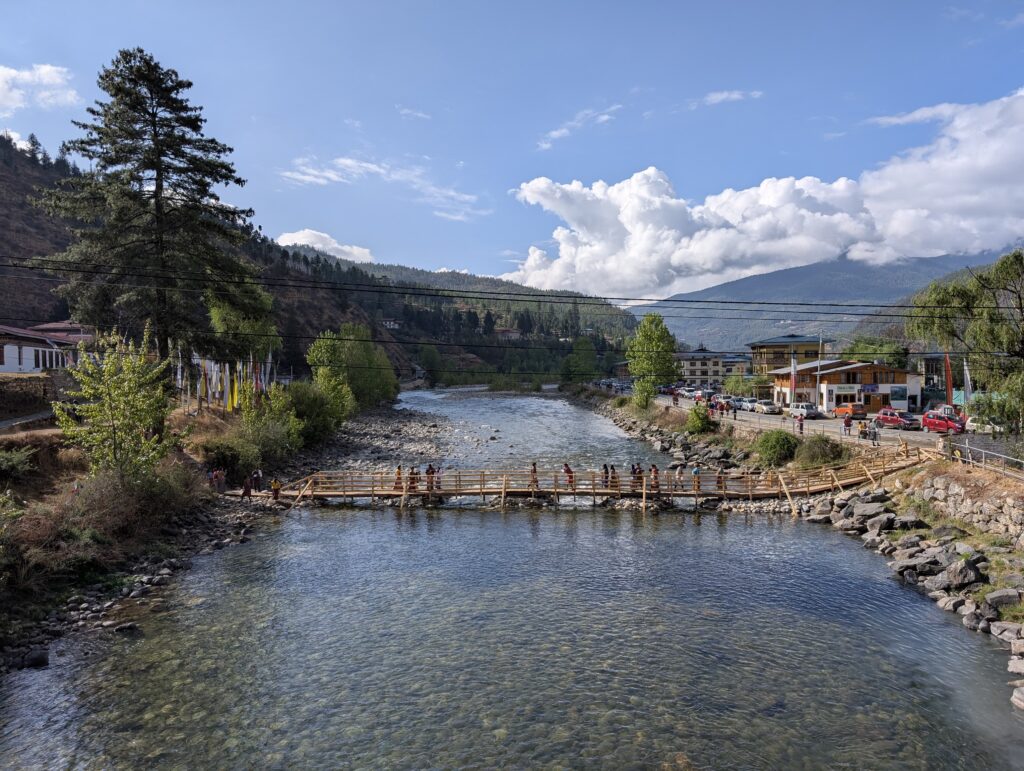
- National Museum of Bhutan (Ta Dzong): Housed in a former watchtower just above the dzong, this circular museum holds treasures — ancient thangkas, protective amulets, traditional weapons, and rare artifacts that offer insight into Bhutan’s deep past.
- Kyichu Lhakhang: One of the oldest and most sacred temples in Bhutan, said to have been built in the 7th century. The inner sanctum radiates stillness, and orange trees in the courtyard are believed to bear fruit year-round.
Must-dos:
- Soak in a traditional hot stone bath at a family-run farmstay. Smooth river stones are heated and dropped into a wooden tub filled with herbed water — relaxing, healing, and deeply Bhutanese.
- Browse local shops for handwoven textiles, intricately carved wooden masks, herbal incense, and silver jewelry. Many shops support women’s cooperatives and local artisans.
Paro is also the perfect base for exploring nearby gems like Tiger’s Nest Monastery and Chele La Pass. But even without leaving the town, its gentle rhythm, traditional architecture, and mountain-framed streets make it one of the most underrated yet rewarding things to do in Bhutan.
2. Witness the Paro Tshechu (Paro Festival)
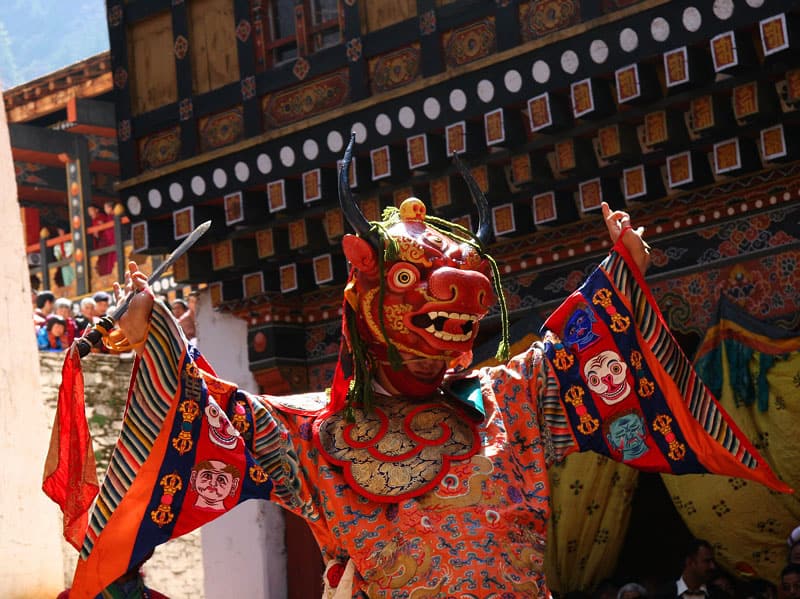
Few experiences in Bhutan pulse with such vivid energy, color, and spiritual power as the Paro Tshechu. Held each spring, usually in March or April, this festival transforms the courtyard of the majestic Rinpung Dzong into a living stage for sacred storytelling. Monks and laypeople alike don vibrant silk costumes and hand-painted masks to perform Cham dances (rituals of purification, protection, and devotion that date back centuries).
As drums thunder and conch shells echo through the valley, masked figures whirl across the stone courtyard, reenacting battles between good and evil, saints and demons, illusion and truth. These are blessings in motion. Locals attend with reverence, dressed in their finest kira and gho, faces lifted to the sun, hands spinning prayer beads. For many Bhutanese, witnessing the festival is a way to accumulate merit and connect with their ancestors.
The Paro Tshechu is one of the most spectacular things to do in Bhutan, especially for visitors seeking a deeper cultural immersion. Timed with the lunar calendar, its dates shift each year, so advance planning is essential.
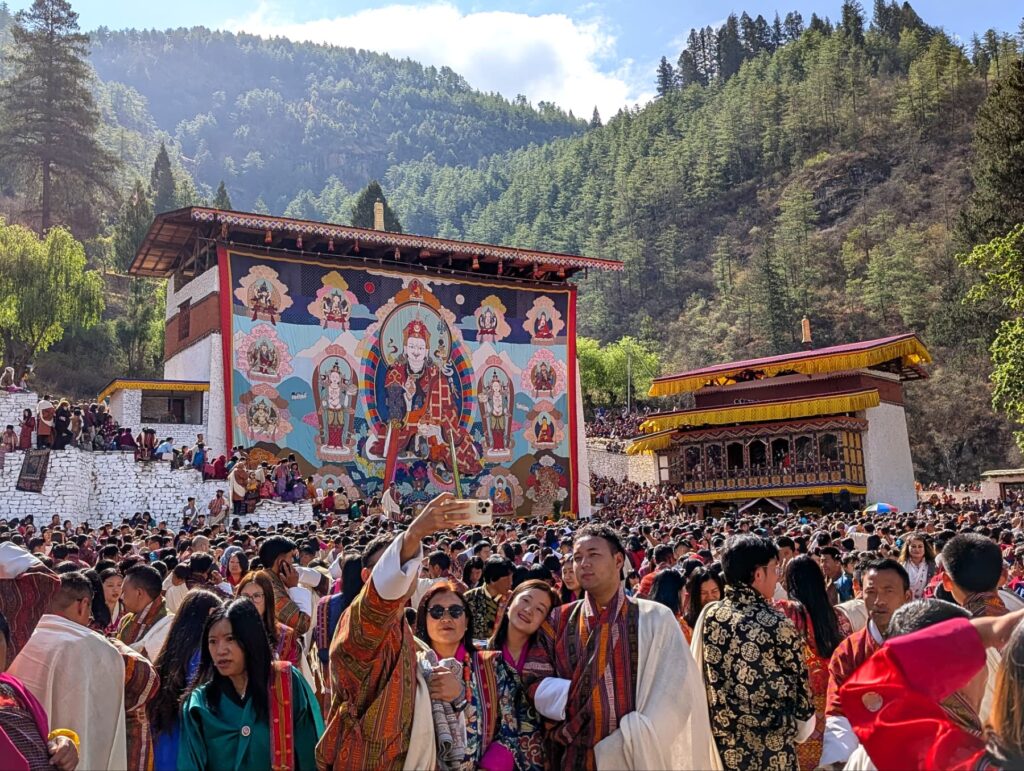
Key highlight: The Thongdrel unveiling
On the final morning, just before sunrise, monks unfurl a massive Thongdrel — a sacred embroidered thangka measuring nearly 30 meters high. It’s so holy that even a glimpse is believed to cleanse a lifetime of sins. The cloth hangs for just a few hours before it is rolled up again for another year. The moment is hushed, awe-filled, and profoundly moving.
Must-dos:
- Arrive before dawn on Thongdrel day to witness the unveiling in the soft blue light of morning.
- Wear respectful attire: long sleeves and covered legs are essential. A scarf or shawl adds a nice touch of local elegance.
- Book your accommodation in Paro at least 4 – 6 months in advance. Festival season is peak travel time, and rooms fill quickly.
- Engage a local guide who can narrate the meanings behind each Cham dance—their mythological roots, gestures, and spiritual purpose.
For culture seekers, this festival is one of the most unforgettable things to do in Bhutan — a rare chance to witness a living tradition that binds an entire community in shared belief, beauty, and joy.
3. Hike to Tiger’s Nest Monastery (Paro Taktsang)
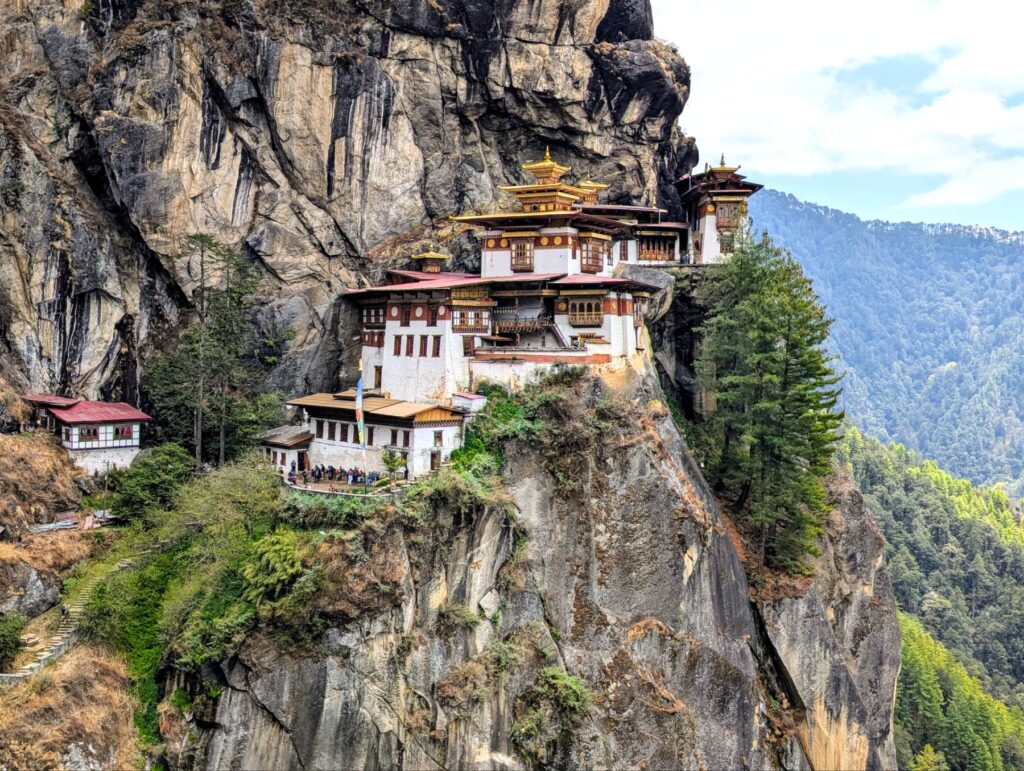
Clinging impossibly to the side of a vertical cliff face high above the Paro Valley, Tiger’s Nest Monastery (Paro Taktsang) looks like a vision from another realm. Coincidentally, visiting this monastery is one of the most iconic and spiritual things to do in Bhutan. At 3,120 meters above sea level, suspended 900 meters above the Paro Valley floor, it looks like something conjured by the gods. A sacred sanctuary carved into rock, built for meditation and pilgrimage, unreachable except by foot and pure intention.
This is no ordinary monastery. Paro Taktsang is one of the most revered sites in the Buddhist world. According to legend, Guru Rinpoche (revered as the Second Buddha) flew here on the back of a tigress in the 8th century to tame a local demon and meditate in a cave. That cave still lies within the monastery’s walls today, accompanied by incense and flickering butter lamps. The existing structure was first built in 1692 and remains active with monks and rituals. Despite suffering damage in a 1998 fire, it was lovingly rebuilt, stone by stone, guided by historical sketches and oral history.
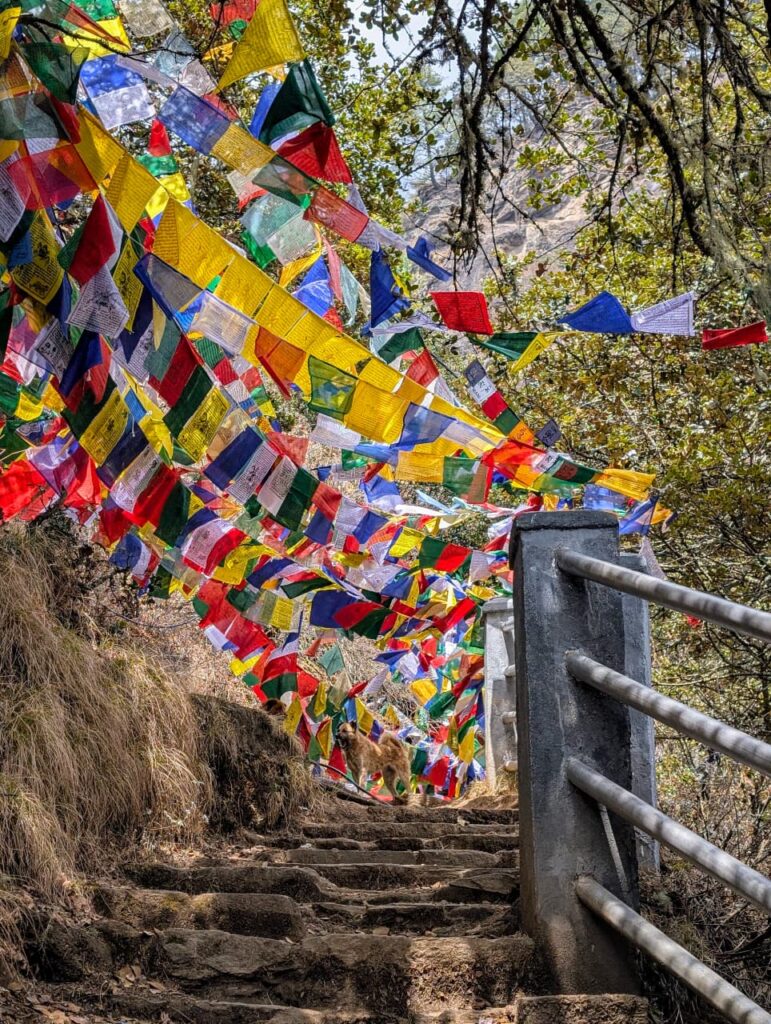
The hike itself is a spiritual rite. The trail begins at the valley floor, winding steadily uphill past moss-covered trees and fluttering prayer flags. It’s a 6-kilometer round trip with a 520-meter elevation gain — moderate in difficulty but demanding in altitude. Most travelers take 4 to 5 hours to complete the trek, including rest stops. You can also spend extra time wandering around the temple grounds, just be prepared for plenty of steep steps within the complex itself.
About halfway, a traditional cafeteria offers warm tea and soul-stirring views of the monastery perched across a deep ravine. From here, the final stretch includes steep stone steps that descend dramatically before climbing again toward the monastery gates. No photography is allowed inside, but what you’ll take with you can’t be captured on film: the hush of the cave, the scent of juniper, and the weight of centuries of prayer.
💡 Tip: For less fit travelers, horses are available for rent to carry you to the midpoint of the ascent. Walking sticks can also be rented (though they’re not professional trekking poles — just sturdy wooden sticks that offer a bit of support along the way).
Must-dos:
- Visit early in the morning for the clearest skies and calmest trail.
- Carry water, wear layers, and bring a walking stick if needed. The descent and ascent near the end can be steep.
- Pause at the mid-way teahouse for a cup of hot butter tea and breathtaking views.
- Hire a licensed Bhutanese guide — they’ll share legends, meanings behind the architecture, and spiritual insight you’d otherwise miss.
4. Soak in the views at Chele La Pass
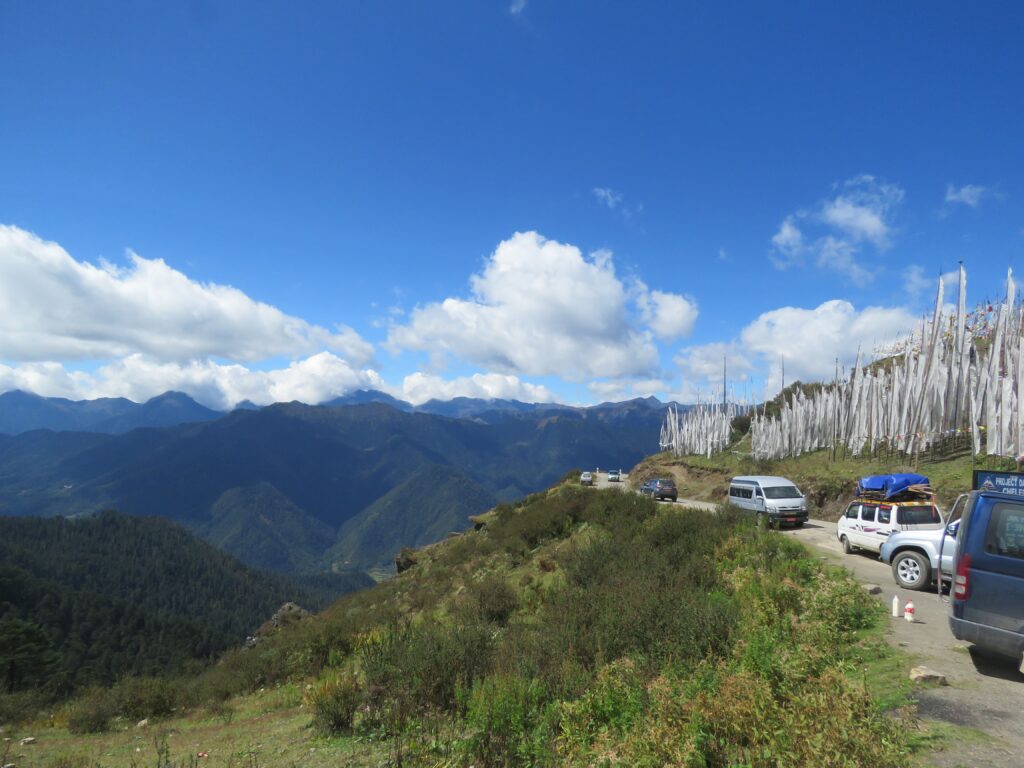
High in the clouds at 3,988 meters above sea level, Chele La Pass is Bhutan’s highest motorable road — and one of its most soul-stirring scenic spots. Located about 35 kilometers from Paro, this pass is often enveloped in mist and prayer flags, with alpine meadows that roll out like a dreamscape.
On clear days, you’ll be rewarded with dramatic views of Mount Jomolhari and Jichu Drake, snow-covered giants that rise like silent guardians at the border of Tibet. Even when the peaks are shrouded, the pass has a raw, moody beauty that makes it worth the trip.
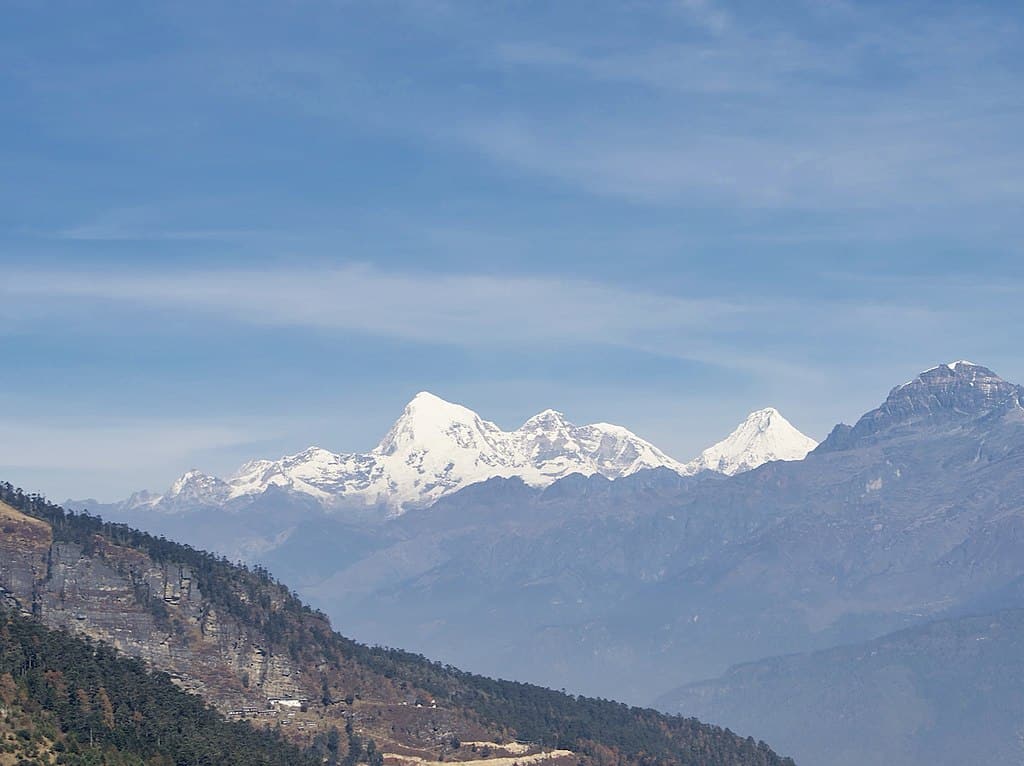
Must-dos:
- Visit in the morning for your best chance of clear skies. Weather here changes quickly.
- Pack a picnic and take your time among the prayer flags — it’s a perfect place to pause and reflect.
- Explore the trail to the Kila Nunnery, tucked into the cliffside below the pass. Travelers should note the trail is not always accessible by vehicle all the way and is subject to weather and road conditions.
For road-trippers and photographers alike, Chele La Pass is one of the most visually unforgettable things to do in Bhutan.
5. Discover the capital, Thimphu
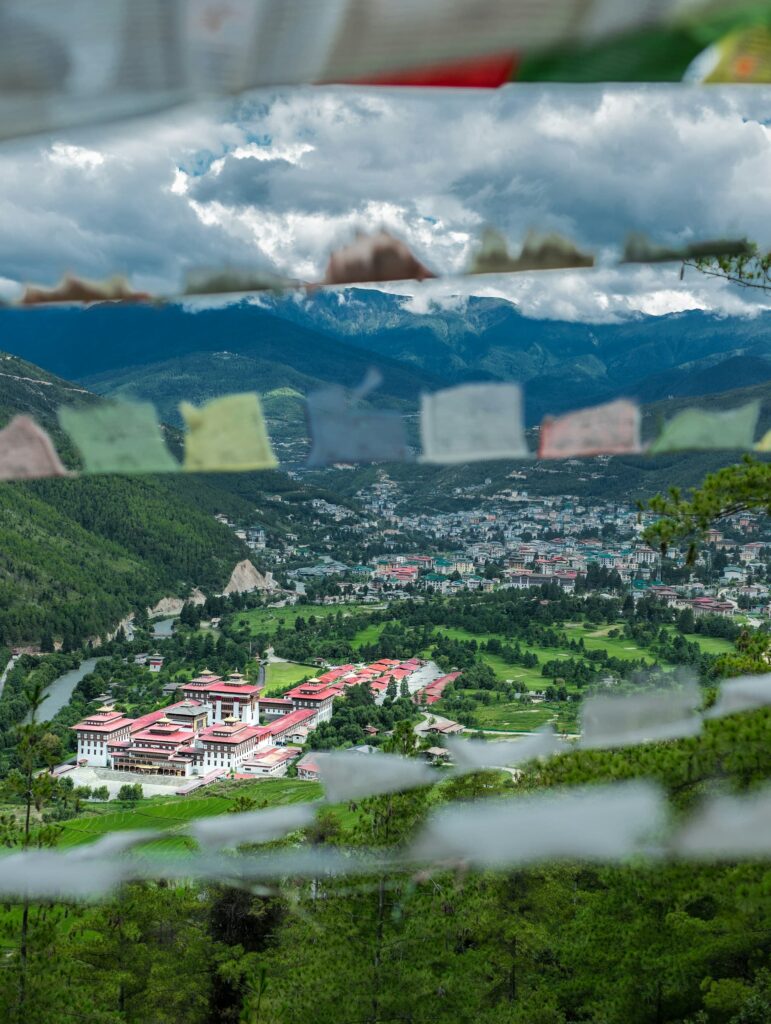
Tucked into a green valley where the mountains fold in around rushing rivers and hillside monasteries, Thimphu is Bhutan’s endearing capital. It’s the only capital city in the world without a single traffic light — just one officer in crisp white gloves who directs the steady, gentle flow of cars at the town’s busiest intersection. In Thimphu, crimson-robed monks scroll through smartphones, towering fortresses house ministries and monks alike, and tradition lives side by side with modernity.
As far as capital cities go, it’s one of the most serene, and yet, endlessly fascinating. From deeply spiritual sites to colorful markets and peaceful hilltop viewpoints, Thimphu is packed with experiences that deserve a place on every list of things to do in Bhutan.
Highlights in Thimphu:
- National Memorial Chorten: Built in 1974 to honor the third King, it’s a living monument. Locals walk clockwise around it in prayer, spinning golden wheels and murmuring mantras from dawn till dusk.
- Tashichho Dzong: This elegant fortress-monastery, dating back to the 17th century, is the seat of Bhutan’s government and the King’s office. By late afternoon, golden light floods the courtyard, and the resident monks file in for evening prayers.
- Simply Bhutan Museum: A living heritage museum where you can walk through reconstructed traditional homes, try your hand at archery, and taste homemade ara (local rice wine).
- Weekend markets (Friday to Sunday): Held along the banks of the Wang Chhu River, this vibrant market buzzes with locals shopping for produce, incense, herbal medicine, and colorful handwoven fabrics.
Must-dos:
- Try suja (butter tea) and ema datshi, Bhutan’s beloved chili cheese stew — spicy, warming, unforgettable.
- Visit Zilukha Nunnery, set on a hill above the city. The view is spectacular, and the atmosphere is serene.
- Step into the National Institute for Zorig Chusum, where you can watch young artists mastering Bhutan’s 13 traditional arts — from thangka painting to woodcarving and embroidery.
- Spend a morning people-watching at the clock tower square or a quiet afternoon at a riverside café. Don’t miss the Textile Museum, a great place to understand Bhutan’s rich weaving traditions.
6. Stand in awe of Buddha Dordenma
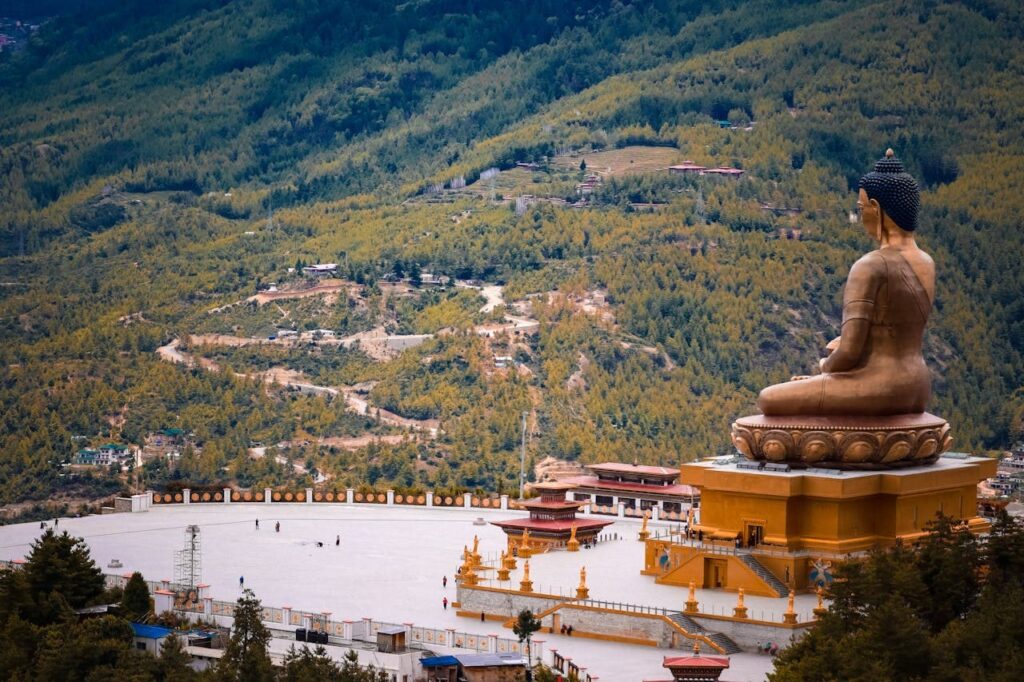
Towering 51 meters into the sky, the golden figure of Buddha Dordenma watches over Thimphu Valley with an expression of serene omniscience. This is not only one of the largest seated Buddha statues in the world, it’s one of the most powerful symbols of Bhutan’s devotion to peace and spiritual prosperity.
Inside the statue are 125,000 smaller Buddhas, each meticulously crafted and placed by hand. The site was built to fulfill a prophecy and celebrate the 60th birthday of the Fourth King of Bhutan. Surrounded by forested hills and offering panoramic views of Thimphu below, this site radiates stillness and scale in equal measure. This towering presence not only dominates the skyline — it captures the heart of Bhutanese devotion.
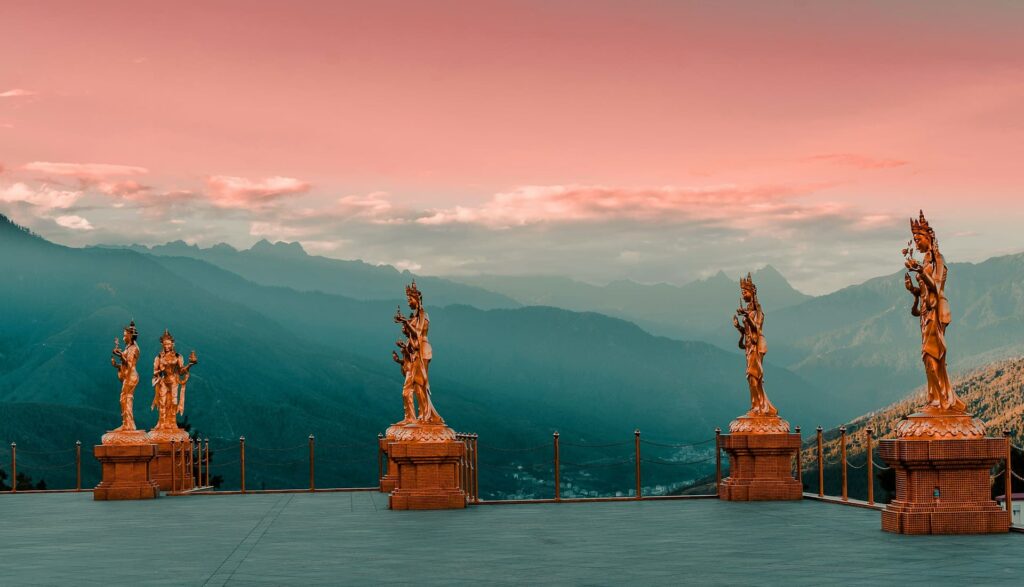
Must-dos:
- Visit near sunset to see the golden figure bathed in amber light, with the city lights flickering on below.
- Walk around the base platform, which features intricately carved murals and stonework.
- Pair your visit with a walk along the Kuensel Phodrang Nature Park trail, which begins nearby.
7. Breathe in the beauty at Dochula Pass
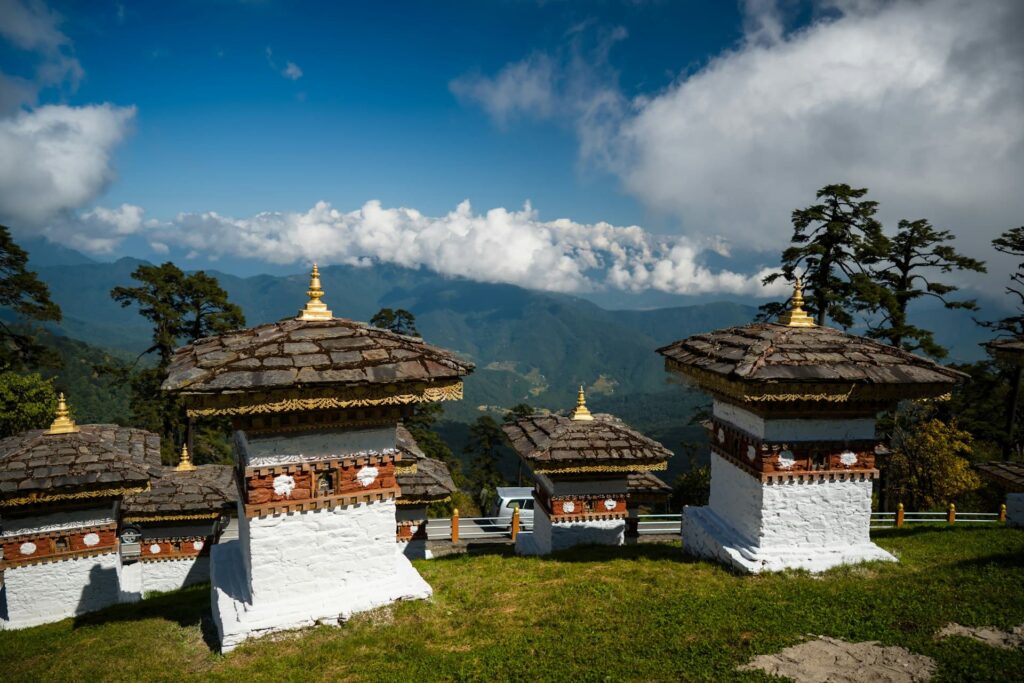
At 3,100 meters above sea level, where clouds drift like silk across jagged ridgelines and the wind carries the soft rustle of prayer flags, Dochula Pass offers a moment of pure Himalayan majesty. Located on the winding road between Thimphu and the Punakha Valley, this mountain pass is more than just a scenic stop — it’s a sacred space suspended between sky and earth.
On a clear morning, 22 snow-capped Himalayan peaks unveil themselves in perfect procession across the horizon, including Gangkhar Puensum, the world’s highest unclimbed mountain. When the skies are overcast, the mist settles in and the pass becomes ethereal, dreamlike — its silence amplified by the rhythmic flutter of flags strung from pine to pine.
At the heart of the pass stand 108 chortens: the Druk Wangyal Chortens, built under the patronage of Queen Mother Ashi Dorji Wangmo Wangchuck to honor Bhutanese soldiers who lost their lives in a 2003 military operation. Their symmetry, presence, and purpose give the entire pass a sense of reverence. As you walk among them, it feels less like sightseeing and more like prayer in motion. Dochula Pass offers one of the most moving things to do in Bhutan — a reminder of life’s fragility and beauty, rendered in stone, wind, and sky.
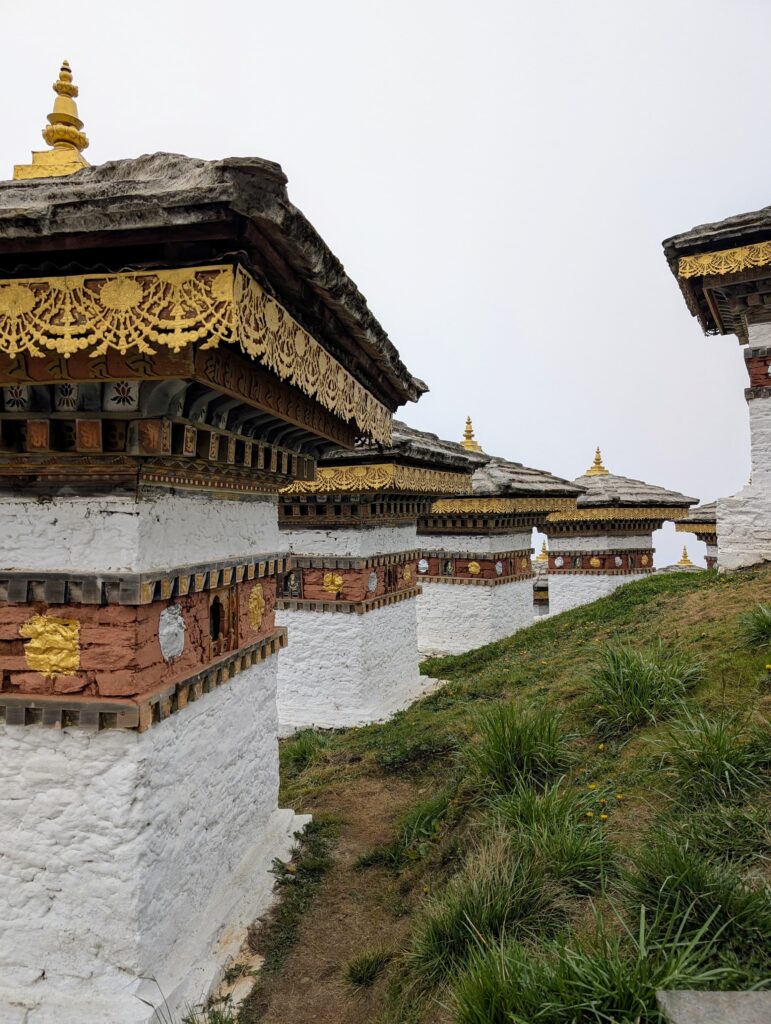
Must-dos:
- Step into Druk Wangyal Lhakhang, a nearby temple with striking murals that blend tradition and modern Bhutanese history — depicting even kings in sunglasses and mountain-climbing monks.
- Pause for a warming cup of butter tea at the Dochula Cafeteria, where panoramic windows frame the clouds and peaks like a living painting.
- Visit during spring (March to May), when vibrant rhododendrons bloom across the surrounding hillsides in shades of crimson, coral, and white.
8. Explore Punakha Dzong: The Palace of Great Happiness
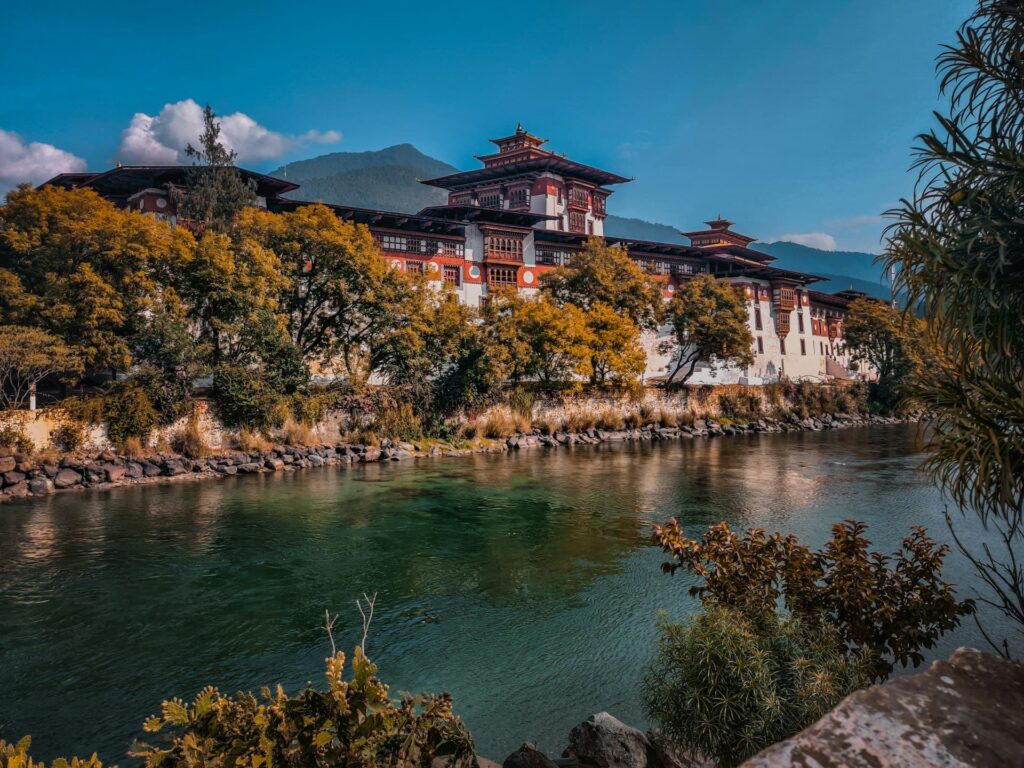
Cradled at the confluence of two rivers — one male, one female — Punakha Dzong rises like a vision from a dream. Soft lilac jacarandas bloom along the banks, their petals drifting into the Mo Chhu and Pho Chhu as monks in deep red robes cross the wooden cantilever bridge. This is not just a fortress. It is a spiritual and historical epicenter, often considered the most breathtaking dzong in all of Bhutan.
Built in 1637 by the unifier of Bhutan, Zhabdrung Ngawang Namgyal, Punakha Dzong is also known as Pungtang Dechen Photrang Dzong, or “The Palace of Great Bliss.” Its walls have witnessed royal weddings, political milestones, and sacred rituals that shaped the nation. For centuries, it served as the seat of Bhutan’s government and now remains the winter residence of the Je Khenpo, Bhutan’s chief abbot.
Inside, carved wooden beams and elaborately painted pillars lead into sun-drenched courtyards where the air smells faintly of incense and cedar. Golden statues, ancient relics, and intricate murals line the walls. From every angle, the dzong tells a story — not just of Bhutan’s past, but of its continuing spiritual heartbeat. Visiting Punakha Dzong is easily one of the most essential things to do in Bhutan.
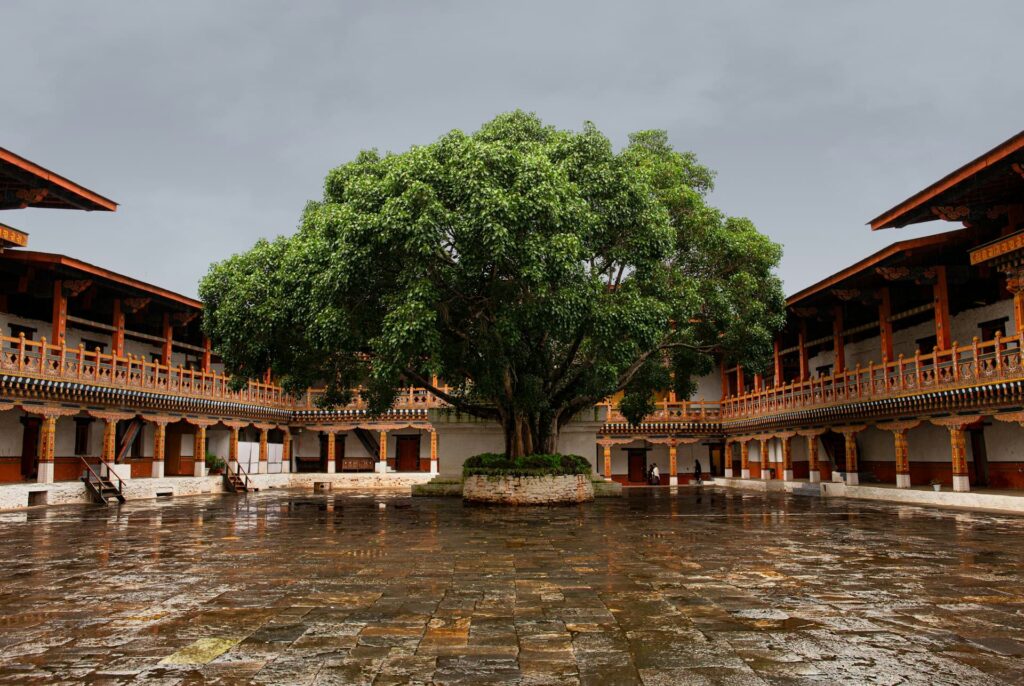
Must-dos:
- Time your visit for the Punakha Tshechu (usually February or March), when monks perform sacred Cham dances in full regalia, and the dzong comes alive with ritual, color, and community.
- Stroll through the riverside gardens in April, when jacaranda trees burst into bloom, cloaking the grounds in soft purple hues — it’s one of the most photogenic moments in Bhutan.
9. Cross the longest suspension bridge in Bhutan

There’s something deeply poetic about walking across a bridge suspended in midair, flanked by fluttering prayer flags and the roar of a glacial-fed river below. At 160 meters long, the Punakha Suspension Bridge is the longest of its kind in Bhutan, and crossing it is as much a meditative experience as it is a visual marvel.
This narrow steel-cabled bridge sways gently over the Pho Chhu River, linking Punakha town to remote villages, rice paddies, and hidden trails on the other side. Adorned with hundreds of multicolored prayer flags, it feels like a sacred passage between worlds. Step by step, the mountains stretch wider around you, the valley opens below, and time itself seems to slow.
Though often overshadowed by the grandeur of Punakha Dzong, this bridge is an essential detour and easily one of the most serene and unexpectedly thrilling things to do in Bhutan.
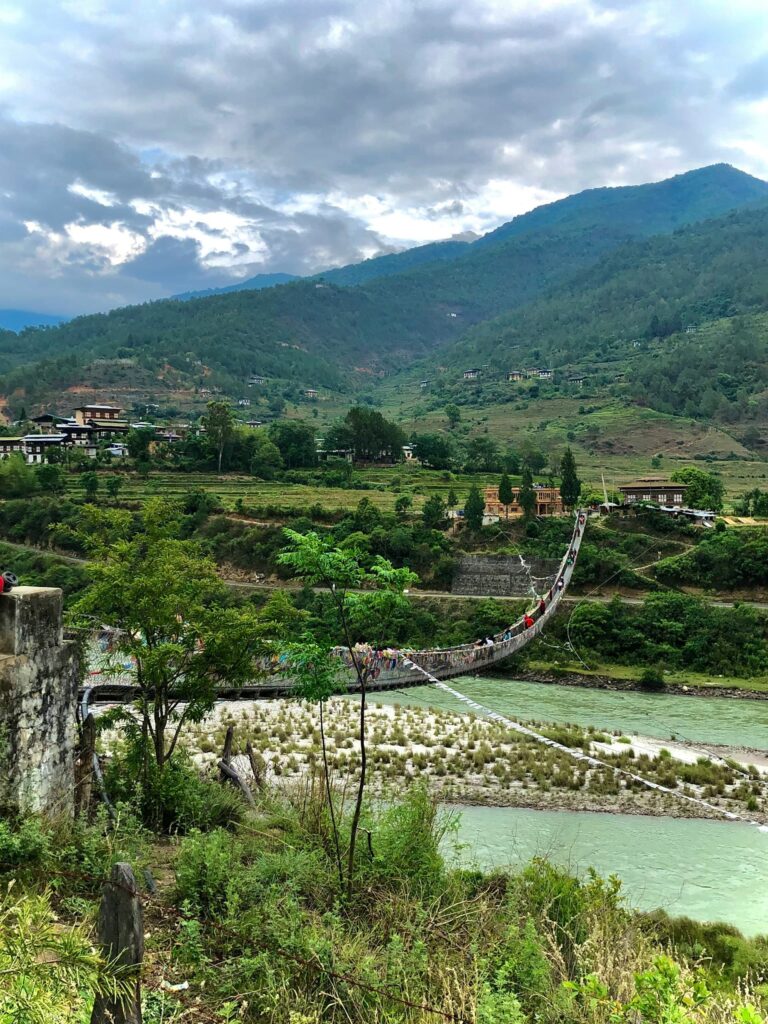
What makes it special:
- Unlike many suspension bridges, this one is used daily by locals. You might pass schoolchildren, monks in maroon robes, or farmers balancing baskets of vegetables as you walk.
- The gentle sway underfoot is perfectly safe but enough to awaken all your senses — especially when the wind picks up and the prayer flags come to life.
- The views up and down the river are stunning. Mist curls along the water in the early morning, while golden hour paints the valley in warm amber tones.
Quick travel tips for visitors to Bhutan
- Tourist entry: All visitors (except from India, Bangladesh, Maldives) must book via a licensed tour operator.
- Daily fee: Bhutan charges a Sustainable Development Fee (SDF) of USD 100 per person, per night (as of 2025), with the exception of Indian nationals.
- Visa: Your tour operator handles the visa; this can be obtained ahead of time.
- Etiquette: No hats or shoes inside temples. Dress modestly. Always walk clockwise around chortens and stupas.
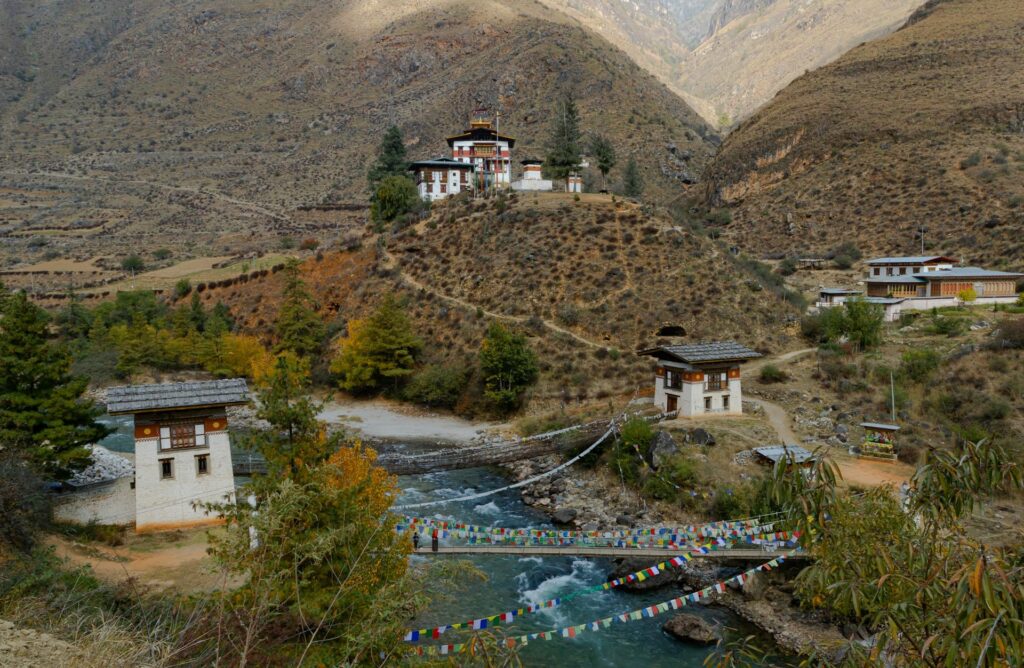
Important facts about Bhutan
Religion in Bhutan: A nation guided by the Dharma
Bhutan is the world’s last remaining Vajrayana Buddhist kingdom, and its identity is inseparable from this ancient spiritual path. Around 75% of the population practices Buddhism, while approximately 22% are Hindus, primarily in southern Bhutan.
The dominant school is Drukpa Kagyu, a lineage of Mahayana Buddhism that emphasizes compassion, meditation, and ritual. The influence of Buddhism is visible in every corner of Bhutan, from the whitewashed stupas lining mountain roads to the monastic schools that echo with chants.
Historically, Bhutan’s religious foundation was laid in the 8th century by Guru Rinpoche (Padmasambhava), who brought Buddhism to the region and subdued local spirits. In the 17th century, Zhabdrung Ngawang Namgyal unified Bhutan under both a spiritual and political system, building many of the dzongs still in use today.
Fast facts:
- Bhutan has over 2,000 monasteries and temples, many of which are centuries old.
- The monastic body is led by the Je Khenpo, Bhutan’s Chief Abbot, who holds power parallel to the King.
- Major festivals (tshechus) are held across the country to celebrate Buddhist teachings through dance, music, and art.
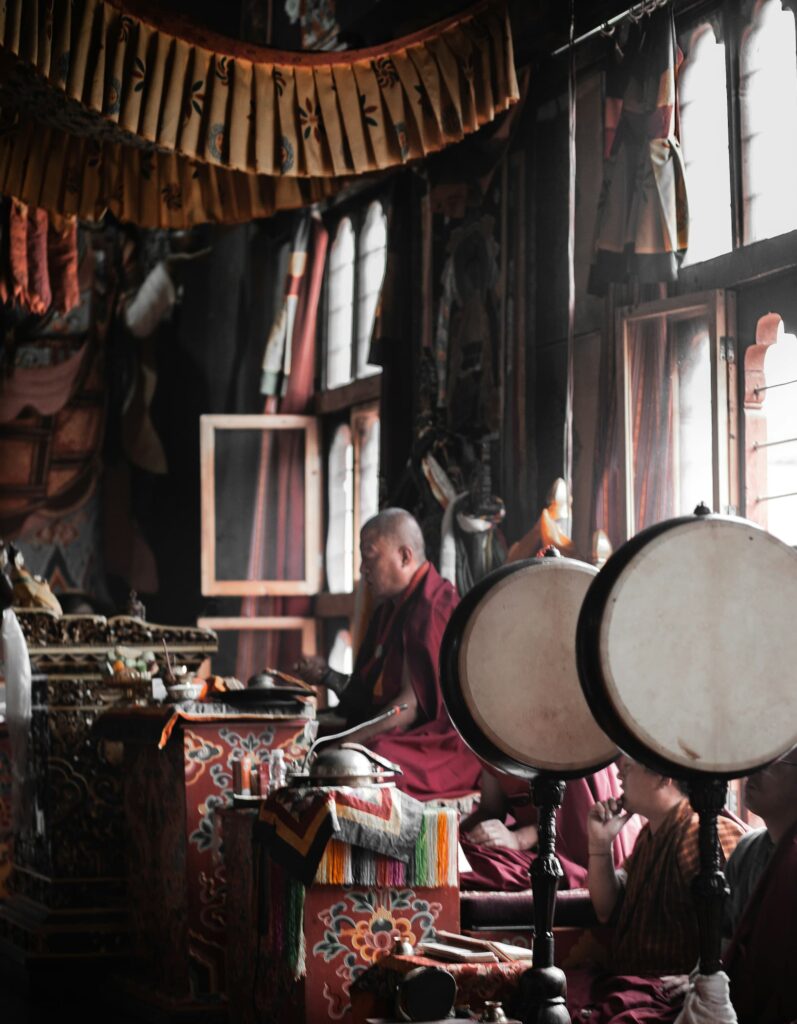
Bhutan language: Dzongkha and the tapestry of tongues
The national language of Bhutan is dzongkha, which literally means “the language of the fortress.” Evolved from Classical Tibetan, it has been the official language since the 1970s. Dzongkha uses the Tibetan script and is spoken primarily in western Bhutan, while various other languages and dialects thrive in other regions.
Bhutan is impressively multilingual for such a small country. Over 19 languages and dialects are spoken across its diverse valleys and districts, including Sharchhopkha in the east and Lhotshamkha (Nepali) in the south. English, however, is widely used in schools, government, and tourism.
Useful dzongkha phrases:
- Hello, goodbye: Kuzuzangpo-la
- Thank you: Kadrinche-la
- How are you?: Gaday bay zhui?
- Yes: Inn / No: Min
- Delicious: Zhim-bay or zhim-mey
While most guides and hotel staff speak English, learning a few words of dzongkha goes a long way — it’s a gesture of respect and curiosity that Bhutanese people genuinely appreciate.
Bhutan currency: What you need to know
The official currency in Bhutan is the Bhutanese ngultrum (BTN), which is at par with the Indian rupee (INR). One ngultrum equals one rupee, and Indian rupees are widely accepted throughout Bhutan (except the ₹2,000 note, which is being phased out in India as of 2023).
Currency tips for travelers:
- Credit cards are accepted at most hotels and some larger restaurants or shops in Thimphu and Paro, but cash is still king elsewhere.
- ATMs are available in major towns, but they may not always accept foreign cards. It’s safest to carry local currency for small purchases and rural travel.
- You can exchange USD, EUR, or other major currencies at the airport, in banks, or via your tour operator.
When budgeting for your trip, remember that Bhutan uses a Sustainable Development Fee (SDF) of USD 100 per night, which goes toward education, healthcare, and infrastructure. Your licensed tour operator will include this in your package price.
Bhutan is largely a cash-based economy, especially in markets, villages, and family-run shops. Keep small bills on hand, and don’t rely solely on plastic.
Bhutan weather: Best time to visit Bhutan
- Spring (March – May): Springtime in Bhutan means mild weather, blooming rhododendrons, and popular festivals like Paro Tshechu. Expect 15 – 25°C daytime temperatures.
- Autumn (September – November): Fall in Bhutan brings clear skies that provide excellent conditions for trekking and photography. Temperatures range from 10 – 22°C.
- Winter (December – February): The cold winter in Bhutan invites fewer tourists. Snowy passes and moody terrain offer great photography opportunities. Paro can dip to -5°C.
- Summer (June – August): Lush landscapes can be expected in summer, but be prepared for monsoon rains and occasional road closures. Temperatures hover around 20 – 26°C.
Transportation and getting around Bhutan
Bhutan’s roads are winding but scenic. As a tourist, you won’t be able to self-drive — only locals and licensed tour operators are permitted to drive in the country. Fortunately, this adds to the ease of travel, as your driver will be well-versed in Bhutan’s terrain and road conditions.
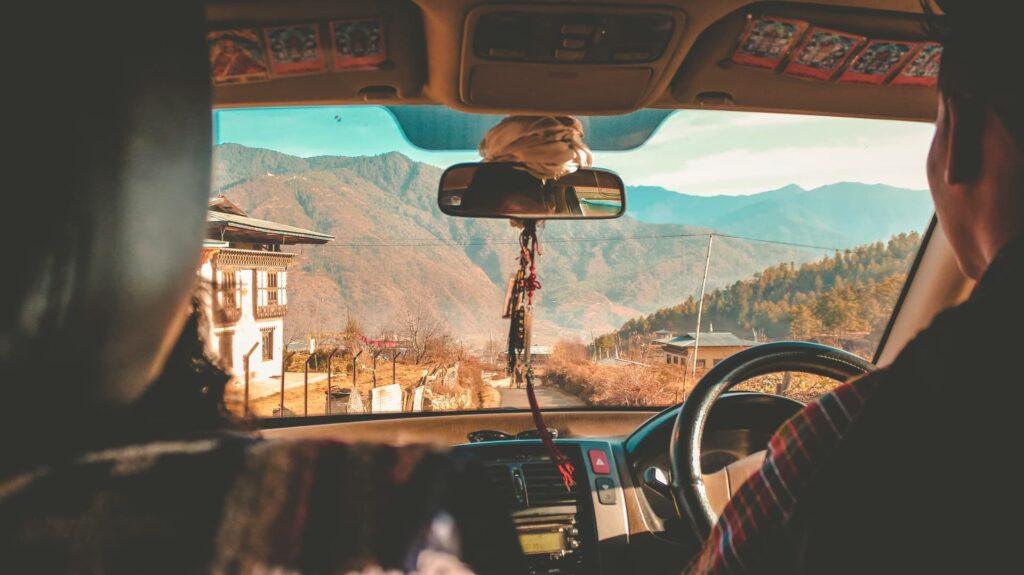
Road conditions vary with the seasons. While most routes are paved and well-maintained, they can be narrow and are sometimes affected by landslides during the summer monsoon. For the best views during your drives, choose a seat on the left side of the car, especially when heading east.
How to get to Bhutan: Flights and airports
Paro International Airport (PBH) serves as the sole international gateway into the country. Operated by Drukair (Royal Bhutan Airlines) and Bhutan Airlines, flights are limited. Here’s how to plan your route.
Major Flight Routes to Paro International Airport (PBH)
🇹🇭 From Bangkok (BKK)
Bangkok continues to be the most frequent and convenient hub for flights to Bhutan. Both Drukair and Bhutan Airlines operate regular flights between Bangkok and Paro. Drukair flights from Bangkok to Paro are scheduled multiple times a week, typically departing early morning and arriving in Paro by mid-morning.
The flight takes about 3 hours and covers a distance of approximately 1,240 miles.
🇳🇵 From Kathmandu (KTM)
Flights from Kathmandu to Paro offer dramatic views of Mount Everest and other Himalayan peaks on clear days. Drukair operates regular flights on this route, with additional flights added during peak seasons.
The flight duration is approximately 1 hour and covers a distance of about 250 miles.
🇮🇳 From Delhi (DEL) and Kolkata (CCU)
Regular flights connect Paro with Delhi and Kolkata. Drukair operates flights from Delhi to Paro several times a week, typically departing in the morning. Flights from Kolkata to Paro are also available, with schedules varying by season.
The flight from Delhi takes about 2 hours, covering approximately 465 miles, while the journey from Kolkata is just under 1.5 hours, covering around 400 miles.
🇦🇪 From Dubai (DXB)
Introduced in late 2024 to enhance Bhutan’s connectivity with the Middle East, there are now direct flights from Dubai to Paro, operated by Drukair.
The flight duration is approximately 4 hours and 30 minutes, covering a distance of about 2,106 miles.
Tips for booking your flight:
- Weather considerations: Due to Paro Airport’s location in a deep valley surrounded by high mountains, flights are subject to weather conditions and can be rescheduled or delayed. It’s advisable to include buffer days in your itinerary to accommodate potential changes.
- Advance booking: Given the limited number of flights, especially during peak tourist seasons, it’s recommended to book your flights well in advance
Want to experience Bhutan your way?
Planning a trip to Bhutan can feel overwhelming, but it doesn’t have to be. With TourHero, you can build a custom itinerary with the help of experienced travel planners who know Bhutan inside and out. Whether you’re dreaming of sacred hikes, vibrant festivals, or sightseeing experiences, we’ll help you create a journey filled with meaning — and none of the stress.
✅ Fully customizable group trips
✅ Connect with local guides
✅ Flexible payment plans
✅ Travel with your community, or meet like-minded adventurers
✅ Earn while you explore (yes, really!)
Ready to create something unforgettable?
👉 Host a group trip to Bhutan — plan the ultimate adventure with TourHero.
About TourHero
TourHero is a social travel platform that enables you to travel with like-minded people and fall in love with the journey. We work closely with handpicked local operators to ensure every experience curated is unique and exclusive to your travel group. Come with us on epic adventures and create memories that last a lifetime. Get started here!






